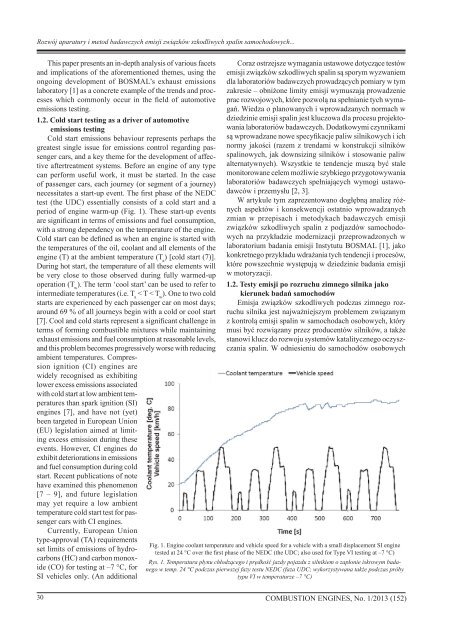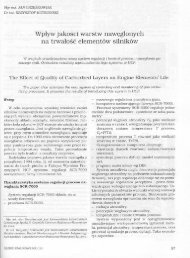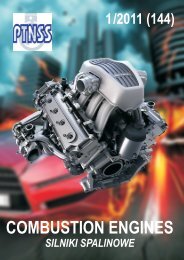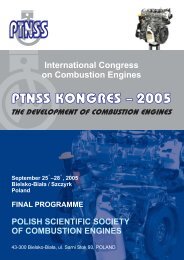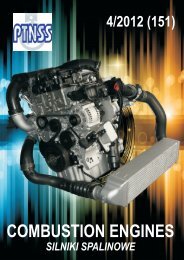Create successful ePaper yourself
Turn your PDF publications into a flip-book with our unique Google optimized e-Paper software.
Rozwój aparatury i metod badawczych emisji związków szkodliwych spalin samochodowych...<br />
This paper presents an in-depth analysis of various facets<br />
and implications of the aforementioned themes, using the<br />
ongoing development of BOSMAL’s exhaust emissions<br />
laboratory [1] as a concrete example of the trends and processes<br />
which commonly occur in the field of automotive<br />
emissions testing.<br />
1.2. Cold start testing as a driver of automotive<br />
emissions testing<br />
Cold start emissions behaviour represents perhaps the<br />
greatest single issue for emissions control regarding passenger<br />
cars, and a key theme for the development of affective<br />
aftertreatment systems. Before an engine of any type<br />
can perform useful work, it must be started. In the case<br />
of passenger cars, each journey (or segment of a journey)<br />
necessitates a start-up event. The first phase of the NEDC<br />
test (the UDC) essentially consists of a cold start and a<br />
period of engine warm-up (Fig. 1). These start-up events<br />
are significant in terms of emissions and fuel consumption,<br />
with a strong dependency on the temperature of the engine.<br />
Cold start can be defined as when an engine is started with<br />
the temperatures of the oil, coolant and all elements of the<br />
engine (T) at the ambient temperature (T a<br />
) [cold start (7)].<br />
During hot start, the temperature of all these elements will<br />
be very close to those observed during fully warmed-up<br />
operation (T w<br />
). The term ‘cool start’ can be used to refer to<br />
intermediate temperatures (i.e. T a<br />
< T < T w<br />
). One to two cold<br />
starts are experienced by each passenger car on most days;<br />
around 69 % of all journeys begin with a cold or cool start<br />
[7]. Cool and cold starts represent a significant challenge in<br />
terms of forming combustible mixtures while maintaining<br />
exhaust emissions and fuel consumption at reasonable levels,<br />
and this problem becomes progressively worse with reducing<br />
ambient temperatures. Compression<br />
ignition (CI) engines are<br />
widely recognised as exhibiting<br />
lower excess emissions associated<br />
with cold start at low ambient temperatures<br />
than spark ignition (SI)<br />
engines [7], and have not (yet)<br />
been targeted in European Union<br />
(EU) legislation aimed at limiting<br />
excess emission during these<br />
events. However, CI engines do<br />
exhibit deteriorations in emissions<br />
and fuel consumption during cold<br />
start. Recent publications of note<br />
have examined this phenomenon<br />
[7 – 9], and future legislation<br />
may yet require a low ambient<br />
temperature cold start test for passenger<br />
cars with CI engines.<br />
Currently, European Union<br />
type-approval (TA) requirements<br />
set limits of emissions of hydrocarbons<br />
(HC) and carbon monoxide<br />
(CO) for testing at –7 °C, for<br />
SI vehicles only. (An additional<br />
Coraz ostrzejsze wymagania ustawowe dotyczące testów<br />
emisji związków szkodliwych spalin są sporym wyzwaniem<br />
dla laboratoriów badawczych prowadzących pomiary w tym<br />
zakresie – obniżone limity emisji wymuszają prowadzenie<br />
prac rozwojowych, które pozwolą na spełnianie tych wymagań.<br />
Wiedza o planowanych i wprowadzanych normach w<br />
dziedzinie emisji spalin jest kluczowa dla procesu projektowania<br />
laboratoriów badawczych. Dodatkowymi czynnikami<br />
są wprowadzane nowe specyfikacje paliw silnikowych i ich<br />
normy jakości (razem z trendami w konstrukcji silników<br />
spalinowych, jak downsizing silników i stosowanie paliw<br />
alternatywnych). Wszystkie te tendencje muszą być stale<br />
monitorowane celem możliwie szybkiego przygotowywania<br />
laboratoriów badawczych spełniających wymogi ustawodawców<br />
i przemysłu [2, 3].<br />
W artykule tym zaprezentowano dogłębną analizę różnych<br />
aspektów i konsekwencji ostatnio wprowadzanych<br />
zmian w przepisach i metodykach badawczych emisji<br />
związków szkodliwych spalin z podjazdów samochodowych<br />
na przykładzie modernizacji przeprowadzonych w<br />
laboratorium badania emisji Instytutu BOSMAL [1], jako<br />
konkretnego przykładu wdrażania tych tendencji i procesów,<br />
które powszechnie występują w dziedzinie badania emisji<br />
w motoryzacji.<br />
1.2. Testy emisji po rozruchu zimnego silnika jako<br />
kierunek badań samochodów<br />
Emisja związków szkodliwych podczas zimnego rozruchu<br />
silnika jest najważniejszym problemem związanym<br />
z kontrolą emisji spalin w samochodach osobowych, który<br />
musi być rozwiązany przez producentów silników, a także<br />
stanowi klucz do rozwoju systemów katalitycznego oczyszczania<br />
spalin. W odniesieniu do samochodów osobowych<br />
Fig. 1. Engine coolant temperature and vehicle speed for a vehicle with a small displacement SI engine<br />
tested at 24 °C over the first phase of the NEDC (the UDC; also used for Type VI testing at –7 °C)<br />
Rys. 1. Temperatura płynu chłodzącego i prędkość jazdy pojazdu z silnikiem o zapłonie iskrowym badanego<br />
w temp. 24 °C podczas pierwszej fazy testu NEDC (faza UDC; wykorzystywana także podczas próby<br />
typu VI w temperaturze –7 °C)<br />
30 <strong>COMBUSTION</strong> <strong>ENGINES</strong>, No. 1/2013 (152)


